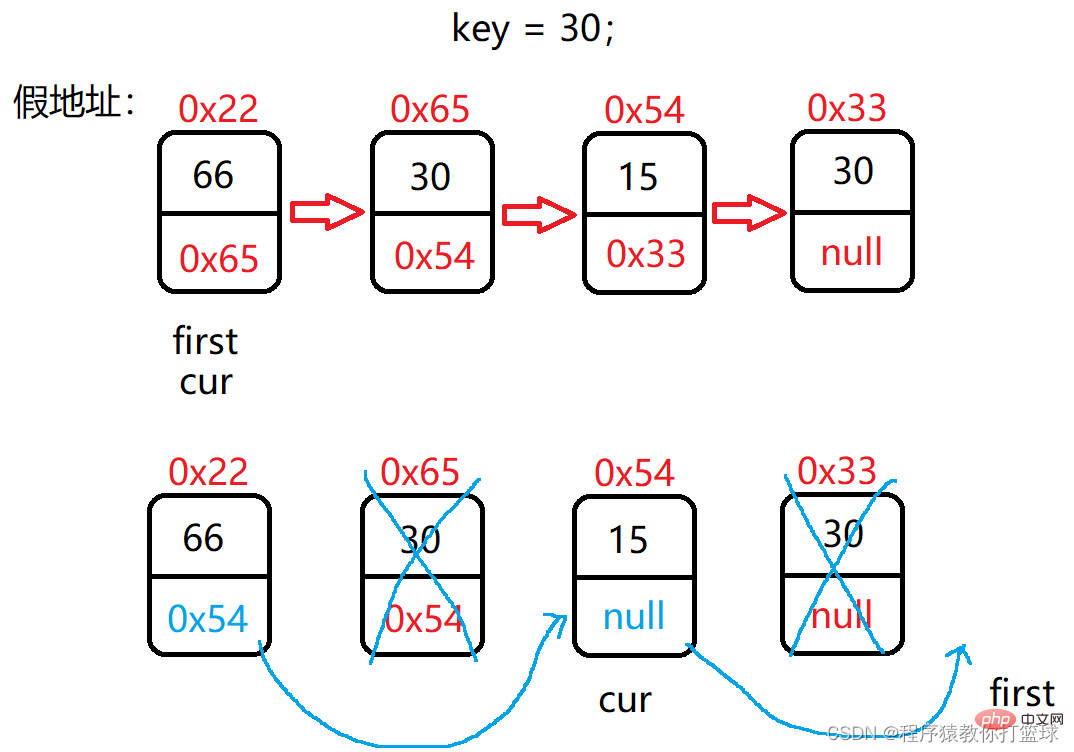Java資料結構之單連結串列與OJ題

程式設計師必備介面測試偵錯工具:
推薦學習:《》
1、什麼是連結串列?
連結串列是一種物理儲存結構上非連續儲存結構,資料元素的邏輯順序是通過連結串列中的參照連結次序實現的 。
通俗點,就是每個元素是一個節點,然後用一個指標域給後面的節點連起來,第一個節點沒有前驅,最後一個節點沒有後繼。

實際中要實現的連結串列的結構非常多樣,以下情況組合起來就有8種連結串列結構:
1. 單向、雙向 2. 帶頭、不帶頭 3. 迴圈、非迴圈
我們重點講解單向非迴圈連結串列和雙向非迴圈連結串列,同時這兩個也是筆試中考的比較多的。
2、實現一個單向非迴圈連結串列
2.1 實現前的約定
因為連結串列的每個元素是一個節點,所以我們採取內部類的方式,而我們還需要定義一個頭節點的參照,來始終指向頭節點。
public class MySingleList {
private ListNode head; //參照頭節點
// 連結串列每個元素是一個節點
private class ListNode {
private int val; //存放資料元素
private ListNode next; //存放下一個節點地址
//構造方法
public ListNode(int val) {
this.val = val;
}
}
}登入後複製注意:連結串列最少有兩個域,分別是資料域和指標域,當然你也可以有多個資料域和指標域。
我們還需要實現以下幾個常用的方法:
public void addFirst(int data); //頭插法
public void addLast(int data); //尾插法
public boolean addIndex(int index,int data); //任意位置插入,第一個資料節點為0號下標
public boolean contains(int key); //查詢關鍵字key是否在單連結串列當中
public void remove(int key); //刪除第一次出現關鍵字為key的節點
public void removeAllKey(int key); //刪除所有值為key的節點
public int size(); //得到單連結串列的長度
public void clear(); //清空連結串列
登入後複製2.2 addFirst 方法
public void addFirst(int data) {
ListNode newNode = new ListNode(data); //把傳過來的值放到新的節點中
newNode.next = this.head; //新節點的next指向頭節點
this.head = newNode; //使新節點成為頭節點
}登入後複製因為head預設是指向空的,當連結串列為null,也不影響這個程式碼的執行,不信你下來畫畫圖咯。
2.3 addList 方法
public void addLast(int data) {
ListNode newNode = new ListNode(data);
// 如果連結串列為空的情況
if (this.head == null) {
this.head = newNode;
return;
}
// 先找到最後一個節點
ListNode cur = this.head;
while (cur.next != null) {
cur = cur.next;
}
cur.next = newNode;
}登入後複製2.4 addIndex 方法
//任意位置插入,第一個資料節點為0號下標
private ListNode findIndexPrevNode(int index) {
ListNode cur = this.head;
while (index - 1 != 0) {
cur = cur.next;
index--;
}
return cur;
}
public boolean addIndex(int index,int data) {
// 判斷index下標的有效性
if (index < 0 || index > size()) {
return false;
}
// 如果在0下標插入則是頭插
if (index == 0) {
addFirst(data); //頭插
return true;
}
// 如果在末尾插入則是尾插
if (index == size()) {
addLast(data); //尾插
return true;
}
ListNode newNode = new ListNode(data); //新節點
// 在中間插入
ListNode prevNode = findIndexPrevNode(index); //找到index下標的前一個節點
newNode.next = prevNode.next; //新節點的next被改為index的位置的節點
prevNode.next = newNode; //index位置前一個節點next被改成新節點
return true;
}登入後複製這個程式碼我們首先需要找到index下標的前一個節點,先讓新節點跟index位置的節點繫結起來,在把index的前一個節點與新節點連起來,這個地方說文字是不清楚的,小夥伴們可以下來按照我這個程式碼畫圖就能理解了,也可也直接看博主之前的C語言實現資料結構專欄,那裡面有圖解哈。
2.5 contains 方法
//查詢關鍵字key是否在單連結串列當中
public boolean contains(int key) {
// 當連結串列為空的情況
if (this.head == null) {
return false;
}
ListNode cur = this.head;
// 遍歷列表
while (cur != null) {
if (cur.val == key) {
return true; //找到了返回true
}
cur = cur.next;
}
return false; //找不到返回false
}登入後複製思路很簡單,遍歷一遍連結串列,找到 cur 為空位置,如果有返回true,沒有返回false,交給小夥伴自己下來畫圖咯。
2.6 remove 方法
//刪除第一次出現關鍵字為key的節點
public void remove(int key) {
if (this.head == null) {
return;
}
ListNode cur = this.head;
// 如果刪除的是key為頭節點
if (this.head.val == key) {
this.head = head.next;
return;
}
// 這裡不能是cur!=null, 不然會越界!!!
while (cur.next != null) {
// 找到 key 的前一個節點
if (cur.next.val == key) {
//當前的cur為key的前一個節點
cur.next = cur.next.next; //cur連結到key的後一個節點
return;
}
cur = cur.next;
}
}登入後複製這裡我們需要找到key的前一個節點,然後進行跟key後面的節點繫結即可,當key對應節點沒人蔘照了,則會被自動回收掉。
2.7 removeAllKey 方法
//刪除所有值為key的節點
public void removeAllKey(int key) {
if (this.head == null) {
return;
}
// 採用前後指標的方法
ListNode cur = this.head;
ListNode prev = this.head;
while (cur != null) {
if (cur.val == key) {
prev.next = cur.next; //跳過key節點指向下一個節點
} else {
prev = cur;
}
cur = cur.next;
}
// 判斷第一個節點是不是key
if (this.head.val == key) {
this.head = this.head.next; //head指向下一個節點
}
}登入後複製這裡大傢伙先自己看看,後面講解OJ題會有這道題詳解的。
2.8 size 和 clear 方法
我相信這兩個方法就不需要多說了吧?遍歷?直接頭指標置null?這不就簡單了嗎,這裡就不寫了哈,交給各位了!
3、單連結串列OJ題深度解剖
這個才是今天的重頭戲,不是籃球哥不畫圖,是因為前面的圖太簡單了,小夥伴們結合著程式碼也能自己畫出來,但是,對於OJ題,大傢伙下去還是得畫圖的,相信看完這幾道題,你會愛上資料結構的。
3.1 移除連結串列元素(來源:LeetCode 難度:簡單)
題目:給你一個連結串列的頭節點
head和一個整數val,請你刪除連結串列中所有滿足Node.val == val的節點,並返回 新的頭節點 。
這個題我們可以用前後指標的思路來做,這樣也比較通俗易懂,更適合初學者,大概的思路是這樣的:我們可以定義一個cur和first的參照,如果碰到相等,也就是first.val == val,我們則讓cur的next指向first的下一個節點,如果不相等,則讓cur走到first的位置,最後first往後走一步,圖解:

這裡還沒有完,如果第一個節點的值也是val呢?所以最後我們別忘了進行一個判斷,那麼最終的程式碼是這樣的:
public ListNode removeElements(ListNode head, int val) {
if (head == null) {
return null;
}
ListNode cur = head;
ListNode first = head;
while (first != null) {
if (first.val == val) {
cur.next = first.next;
} else {
cur = first;
}
first = first.next;
}
// 判斷頭節點的值是否也是val
if (head.val == val) {
head = head.next;
}
return head;
}登入後複製3.2 反轉連結串列(來源:LeetCode 難度:簡單)
題目:給你單連結串列的頭節點
head,請你反轉連結串列,並返回反轉後的連結串列。
這個題我們可以先取到頭節點,後續的節點都進行頭插法即可?我們取到頭節點,並且先將頭節點的next置空,但是這樣一來,就找不到後面的節點了,所以我們還需要有一個curNext參照來記錄要反轉節點的下一個節點:
我們的思路是這樣的:首先找到頭節點的next置空,cur走到curNext位置,curNext往前走,使得cur位置的next指向頭節點,頭節點cur再次成為新的頭節點,當curNext走到null的時候迴圈結束。
public ListNode reverseList(ListNode head) {
// 空連結串列的情況
if (head == null) {
return null;
}
ListNode cur = head;
ListNode curNext = cur.next;
head.next = null;
while (curNext != null) {
cur = curNext;
curNext = curNext.next;
cur.next = head;
head = cur;
}
return head;
}登入後複製3.4 連結串列中倒數第k個節點
題目:輸入一個連結串列,輸出該連結串列中倒數第k個結點。
這個題也是很簡單的一道題,可以採用前後指標法,先讓first指標走k步,走完之後slow和first一起走,這樣slow和first之間就相差了k步,當first為null時,slow就是倒數第k個節點,在這個過程中,我們還要判斷k的合法性,如果k小於等於0?或者k大於連結串列的長度呢?於是我們就能寫出如下的程式碼:
public ListNode FindKthToTail(ListNode head,int k) {
// 判斷k的合法性
if (k <= 0 || head == null) {
return null;
}
ListNode first = head;
ListNode slow = head;
// 先讓first走k步
while (k != 0) {
// k的長度大於連結串列的長度
if (first == null) {
return null;
}
first = first.next;
k--;
}
// 一起走,當first為null,slow就是倒數第k個節點
while (first != null) {
first = first.next;
slow = slow.next;
}
return slow;
}登入後複製3.6 連結串列分割(來源:牛客網 難度:較難)
題目:現有一連結串列的頭指標 ListNode* pHead,給一定值x,編寫一段程式碼將所有小於x的結點排在其餘結點之前,且不能改變原來的資料順序,返回重新排列後的連結串列的頭指標。
這個題的思路我們可以這樣做,既然是按照給定的值x進行分割,那麼我們設定兩個盤子,盤子A放小於x的節點,盤子B放大於x的節點,最後把這兩個盤子的節點連起來,放回盤子A的頭節點即可!
public ListNode partition(ListNode pHead, int x) {
if (pHead == null) {
return null;
}
ListNode headA = null;
ListNode headB = null;
ListNode curA = null;
ListNode curB = null;
ListNode cur = pHead;
while (cur != null) {
if (cur.val < x) {
// 第一次放入A盤子
if (headA == null) {
headA = cur;
curA = cur;
} else {
curA.next = cur;
curA = cur;
}
} else {
// 第一次放入B盤子
if (headB == null) {
headB = cur;
curB = cur;
} else {
curB.next = cur;
curB = cur;
}
}
cur = cur.next;
}
// 如果A盤子為空
if (headA == null) {
return headB;
}
curA.next = headB;
// 避免B盤子尾節點形成環
if (headB != null) {
curB.next = null;
}
return headA;
}登入後複製3.7 連結串列的迴文結構(來源:LeetCode 難度:較難)
題目:對於一個連結串列,請設計一個時間複雜度為O(n),額外空間複雜度為O(1)的演演算法,判斷其是否為迴文結構。
給定一個連結串列的頭指標A,請返回一個bool值,代表其是否為迴文結構。保證連結串列長度小於等於900。
這個題有要求的,要求空間複雜度為O(1),並且還得在O(n)的時間複雜度下,那我們就原地解決這個題,我們可以分為三個步驟,首先找到中間節點,然後把中間節點往後的節點進行反轉,最後左右兩個指標同時往中間走。如果光看下面程式碼看不懂,可以結合著程式碼畫圖才能理解更透徹哦!
public boolean chkPalindrome(ListNode A) {
if (A == null) {
return false;
}
// 只有一個節點的情況
if (A.next == null) {
return true;
}
// 首先找到中間節點
ListNode first = A;
ListNode slow = A;
while (first != null && first.next != null) {
first = first.next.next;
slow = slow.next;
}
// 走到這,slow是連結串列的中間節點,採用頭插法反轉slow後續的節點
first = slow.next;
ListNode cur = slow;
while (first != null) {
cur = first;
first = first.next;
cur.next = slow; //連結前一個節點
slow = cur; //更新頭節點的位置
}
// 走到這,反轉完畢,cur指向最後一個節點,讓slow等於A,往中間找
slow = A;
while (slow != cur) {
if (slow.val != cur.val) {
return false;
}
// 偶數的情況下需要特殊判斷
if (slow.next == cur) {
return true;
}
slow = slow.next;
cur = cur.next;
}
return true;
}登入後複製3.8 相交連結串列(來源:LeetCode 難度:簡單)
題目:給你兩個單連結串列的頭節點 headA 和 headB ,請你找出並返回兩個單連結串列相交的起始節點。如果兩個連結串列不存在相交節點,返回 null 。
題目資料 保證 整個鏈式結構中不存在環。
注意,函數返回結果後,連結串列必須 保持其原始結構 。
這個題我們可以這樣做,長連結串列先走兩個連結串列的長度差的步數,因為相交之後的節點都是一樣的個數,所以走了差值後,就兩個連結串列一起往後走,相等了則就是相交節點。
public ListNode getIntersectionNode(ListNode headA, ListNode headB) {
if (headA == null || headB == null) {
return null;
}
ListNode longList = headA; //longList始終記錄長的連結串列
ListNode shortList = headB;
// 分別求出兩個連結串列的長度
int lenA = 0;
int lenB = 0;
ListNode cur = headA;
while (cur != null) {
lenA++;
cur = cur.next;
}
cur = headB;
while (cur != null) {
lenB++;
cur = cur.next;
}
int len = lenA - lenB;
// 如果B連結串列長於A連結串列
if (len < 0) {
// 修正相差長度
len = lenB - lenA;
longList = headB; //longList始終記錄長的連結串列
shortList = headA;
}
// 讓長連結串列先走差值len步,然後同步走,相等了即為相交節點
while (len != 0) {
longList = longList.next;
len--;
}
while (longList != shortList) {
longList = longList.next;
shortList = shortList.next;
}
// 如果兩個連結串列走到了null,則沒有中間節點返回null,如果有,返回任意一個即可
return longList;
}登入後複製推薦學習:《》
以上就是Java資料結構之單連結串列與OJ題的詳細內容,更多請關注TW511.COM其它相關文章!
